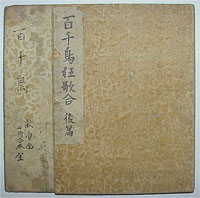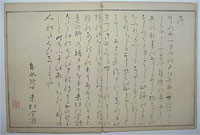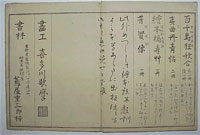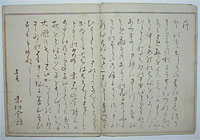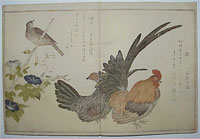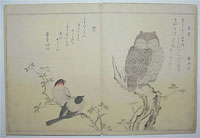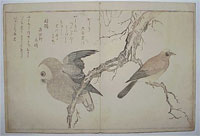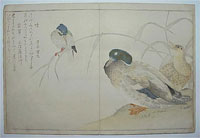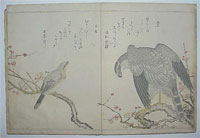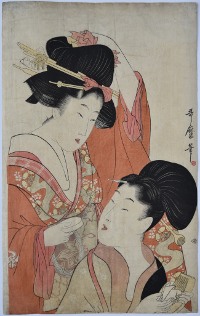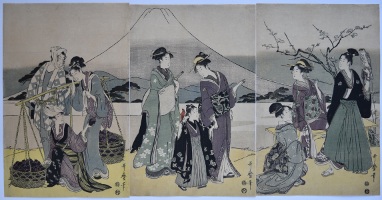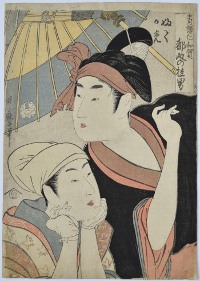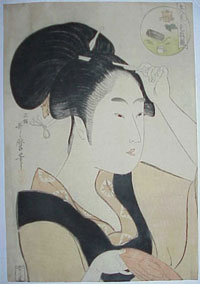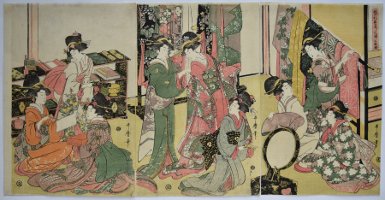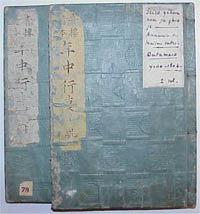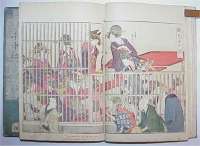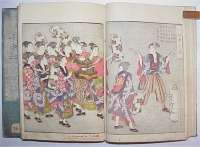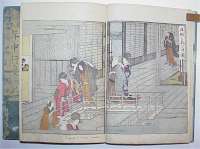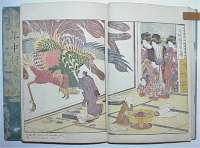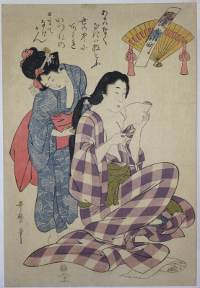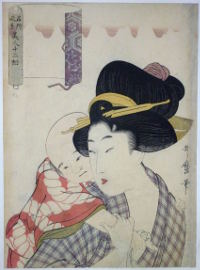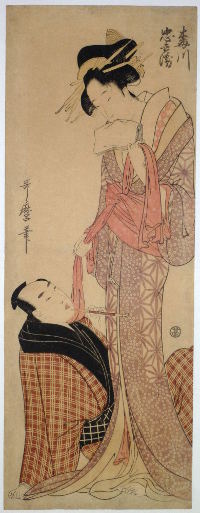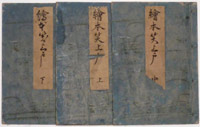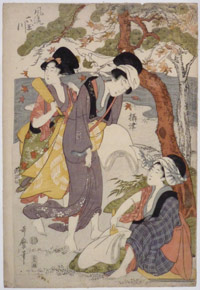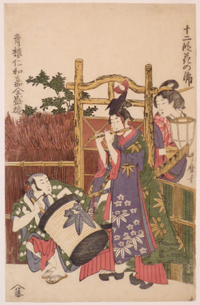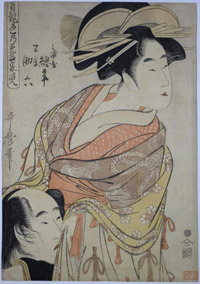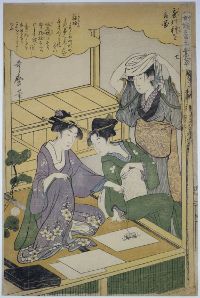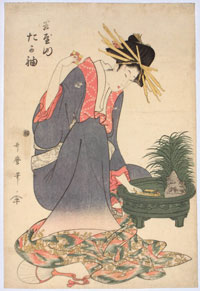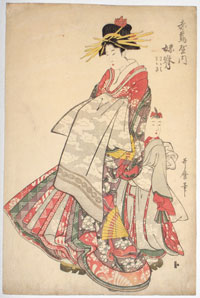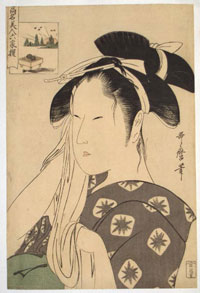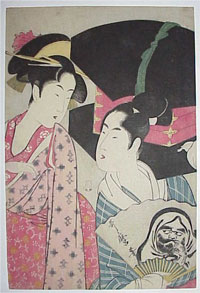Kitagawa UTAMARO (1753-1806)
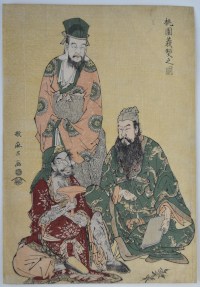
Click here to view image full size.
A scene taken from the Chinese 14th century heroic novel San guo zhi yanyi, “Romance of the Three Kingdoms” attributed to Luo Guanzhong. Shows in the centre Liu Bei (Jap. Ryubei), the founder of the Kingdom of Shu, and the two warriors, Guan Yu (Kan U) on the right and Zhang Fei (Cho Hi) on the left. The three swore pledges of brotherhood in a peach orchard. Toen gikei no zu, “Picture of the Oath in the Peach Orchard. “ Published by Tsutaya Juzaburo with early signature c 1782-3. Rare.
Fine impression. Very good colour: yellow ground. Slight crease down right edge and very small wormage near top right, otherwise very good condition. Signed Utamaro ga.
Status: Available
Kitagawa UTAMARO (1753-1806)
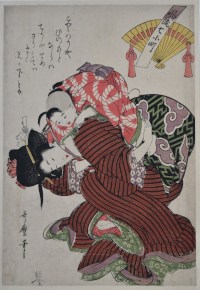
Click here to view image full size.
A beauty with a child on her back. Amagoi Komachi from a set Furyu nana Komachi, “Fashionable Seven Komachi.” Events from the life of Ono no Komachi, one of the six best waka poets of the Heian period. Published by Iseya Soemon, c. 1805.
Very good impression. Fine colour. Slight trimming, otherwise very good condition. Signed Utamaro hitsu.
Status: Available
Kitagawa UTAMARO (1753-1806)
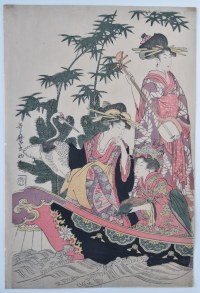
Click here to view image full size.
Presumably the last sheet of a triptych (I cannot locate the complete design at the moment). Shows three geisha representing three of the Seven Lucky Gods: Benzaiten, Fukurokuji, Ebisu. The other sheets would show the other four. They are depicted on the Takarabune, ” Treasure Ship” which has been constructed on a stage with artificial water. Probably an event that occurred during the first three days of the New Year.. Published by Tsuruya Kinsuke, c 1802.
Fine impression. Extremely good colour. Fine condition. Signed Utamaro ga.
Status: Available
Kitagawa UTAMARO (1753-1806)
Click here to view image full size.
Other examples are known with alternative titles which appear to be slightly later. The sequence of the illustrations varies from copy to copy. Of the utmost rarity there appearing to be around thirteen extant copies and considered to be one of the great Japanese illustrated books. Original covers with one original title slip. Covers and title as per B.M. copy.
Covers slightly worn with slight wormage to one cover. Contents very clean with minimal soil, marks, etc. Lacks one of the two identical colophons, but a fine example of this great rarity.
Status: Sold
Kitagawa UTAMARO (1753-1806)
Click here to view image full size.
A beauty being aided by her assistant to dress her hair. Published by Wakasaya Yoichi, c 1803-4.
Fine impression. Very well retained colour. Minor marks and soil, but otherwise very good condition. On thick hosho. Signed Utamaro fude.
Status: Sold
Kitagawa UTAMARO (1753-1806)
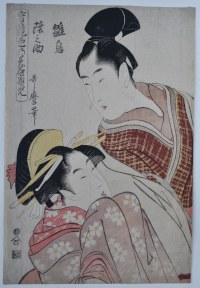
Click here to view image full size.
The lovers Hinadori and Kuganosuke from a series of half-length portraits of pairs of lovers featured in joruri love-suicide plays. (Joruri were bunraku puppet dramas). Jitsu kurabe iro no minakami, “True Feelings Compared: The Founts of Love.” At the height of their popularity the Japanese government cracked down on these joruri plays as they were inspiring copycat double suicides amongst the population. Published by Nishimuraya Yohachi, c 1798-9.
Fine impression. Very good colour. Some paper chain lines visible, otherwise very good condition. Signed Utamaro hitsu.
Status: Sold
Kitagawa UTAMARO (1753-1806)
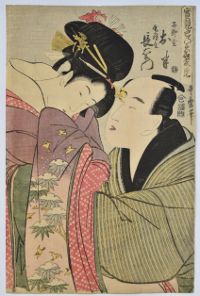
Click here to view image full size.
Shows Shinanoya Ohan (left) and Obiya Choemon from a series of half-length portraits of pairs of lovers featured in joruri love-suicide plays. Jisu kurabe iro no minakami, “True Feelings Compared: The Founts of Love.” Choemon was the adopted heir of Obiya, an obi business in Kyoto. Ohan was a young girl from the Shinanoya store next door. In fact, the drama is based on an actual event in Kyoto during the Kyoho era. Two dead bodies were discovered in the Katsuragawa; one of a 50 year old man, the other of a 14 or 15 year old girl. Published by Nishimuraya “Sei” c 1798-9. Another impression is in the MFA Boston, 11.14296. Provenance: Ex Louis Gonse collection. Rare.
Fine impression. Exceptionally good colour. Fine condition. Signed Utamaro hitsu.
Status: Sold
Kitagawa UTAMARO (1753-1806)
Click here to view image full size.
A benigirai-e (red-avoiding) triptych showing from right to left: A young nobleman with a falcon, a beauty beside him holding his sword and another seated smoking a pipe; the centre panel shows two women and a child holding a small falcon; while the last sheet has two women selecting eggplants from the baskets of an eggplant seller. The backdrop for the whole scene is a majestic Mt. Fuji. The combination of Fuji, falcon and eggplant is known as Ichi-Fuji, Ni-Taka, San-Nasubi (1-Fuji, 2-Falcon, 3-Eggplant) and it is supposed to be good luck to dream of these three in the first dream of the New Year (or, in fact, on the second night, the first being sleepless. The following day is known as hatsuyume). Extremely rare: the only impression I can find is illustrated in Kiyoshi Shibui, Ukiyoe zuten, No. 13, Utamaro, p. 37. (The date given here is 1801, although the late 1790s might be more appropriate as the vogue for benigirai-e [probably as a response to sumptuary edicts] was prevalent around the 1790s.) Published by Murataya Jirobei of Eiyudo. Another triptych by Utamaro of this subject is illustrated in Yoshida, Utamaro zenshu, p. 156. A very fine design.
Fine impression. Extremely good colour: these pigments are very susceptible to any light or moisture. Extremely good condition.Signed Utamaro hitsu.
Status: Sold
Kitagawa UTAMARO (1753-1806)
Click here to view image full size.
A beautiful aiban showing Fuku and Kame from a series Seiro Niwaka, “The Niwaka Festival in the Yoshiwara.” Sub-title Tsuki no Katsurao (Katsura Otoko). The “pleasure district” of Edo hosted the Niwaka Festival in the eighth month of each year where courtesans performed dances and there were entertainers. Published by Tsuruya Kiemon, c 1794-5. Rare: Apparently not listed in the standard Utamaro books.
Fine impression. Very well retained colour, the fugitive blue on the umbrella intact. Small repaired wormhole, otherwise very good condition. Full size. Signed Utamaro fude.
Status: Sold
Kitagawa UTAMARO (1753-1806)
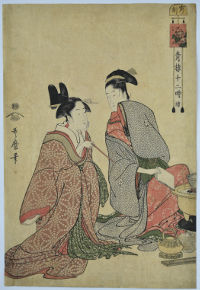
Click here to view image full size.
A scene in the licensed quarter: Tora no koku, “Hour of the Tiger [4am]” from a set Seiro juni toki tsuzuki, “Series: The Twelve Hours in Yoshiwara.” Shows two courtesans chatting and seated before a brazier. Until 1873, the day was divided into twelve equal intervals (of 120 minutes), so ushi no tora was from 3am to 5am. Published by Tsutaya Juzaburo, c. 1794. Rare.
Fine impression. Very good colour; yellow ground. Loss of brass filings, otherwise very good condition. Signed Utamaro hitsu.
Status: Sold
Kitagawa UTAMARO (1753-1806)
Click here to view image full size.
A beauty from the tea-house Suminoe in the district of Shiba from a series: “Comparing the Charms of five Beauties”. The picture-riddle (in the circular cartouche top right) gives the identity of the beauty on each design. In the second edition the riddle is replaced with a flower design. Published by Omiya Gonkuro c.1795-6.
Very good impression. Slight fading. Thinned top left and paper strengthened. Signed Shomei Utamaro hitsu.
Status: Sold
Kitagawa UTAMARO (1753-1806)
An aiban showing a mother and daughter from a set Tosei fuzoku hakkei, “Eight Views of Manners of Today.” This design probably referring to Mother’s Day. Another from the set is illustrated in Ukiyoe Zuten, no. 13, Utamaro, Kiyoshi Shibui, p. 107. Published by Izumiya Ichibei, c 1803.
Fine impression and colour. Minor mark au verso at top, otherwise fine condition. Signed Utamaro hitsu.
Status: Sold
Kitagawa UTAMARO (1753-1806)
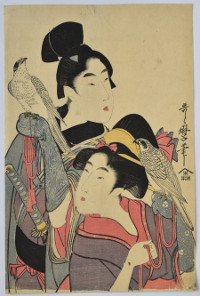
Click here to view image full size.
An aiban showing an elegant couple holding falcons. Takagari, Japanese falconry, is said – as so much else in Japan – to have come from China around the 4th century. A symbol of nobility and a status symbol. Published C 1803.
Fine impression with excellent colour. Minor mark extreme bottom right, otherwise fine condition. Signed Utamaro hitsu.
Status: Sold
Kitagawa UTAMARO (1754-1806)
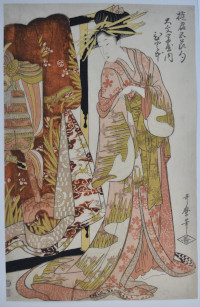
Click here to view image full size.
The courtesan Hitomoto of the Daimonjiya House, Daimonjiya uchi Hitomoto from a set Yukun gosekku, “Courtesans for the Five Festivals.” She stands beside a clothes rack with an elaborate costume patterned with a suite of armour (probably indicating the Boys’ Festival, 5th day of the 5th month), Published 1805 by Wakasaya Yoichi (Jakurindo).
Fine impression. Very good colour with beautiful oxidation of the orange pigment. Probably slightly trimmed at left, otherwise fine condition. Signed Utamaro hitsu.
Status: Sold
Kitagawa UTAMARO (1753-1806)
Click here to view image full size.
A triptych showing a bride changing into her going-away dress, Konrei iro-naoshi no zu. There is another triptych of the actual wedding ceremony which can be viewed with this to form a hexaptych design, Sanmai-tsuzuki. Published by Maruya Bunemon, 1804. Other impressions in Shibui, Ukiyo-e zuten, Utamaro, 1964, p. 38/9; Ukiyo-e Taisei 7, 1931, no. 346; Ukiyo-e shuka 3, 1978, no. 356. Rare.
Fine impression. Very good, well retained colour. Large margins on last two sheets, first sheet very slightly trimmed, otherwise very good condition. Signed Utamaro hitsu.
Status: Sold
Kitagawa UTAMARO (1753-1806)
Click here to view image full size.
(Seiro Ehon) Nenju Gyoji, Yoshiwara Events or “Annals of the Green Houses”. One of Utamaro’s major books showing the annual events in the only government licensed brothel district in the city of Edo (Tokyo). Two volumes complete published Spring 1804 by Kazusaya Chusuke juo. Text by Jippensha Ikku. Original covers and title slips. Very fine copy: Fine impressions with very fine, completely unfaded colours. Slight stain affecting first few pages of text and a small wormhole within binding affecting the first few illustrations.
Covers in very good condition, some rubbing of title slips. Ex collections Theodore Duret (seals on last page of each vol.) and Tadamasa Hayashi (large square seals on first page of each vol.). Catalogue entry (lot 35) pasted onto inside of front cover: “Tres bel exemmplaire en parfait etat”. Also labels identifying each scene in French lightly attached in margin of each design. Certainly one of the finest copies extant.
Status: Sold
Kitagawa UTAMARO (1752-1806)
Click here to view image full size.
A beauty reading while having her hair combed from a series of Nana Komachi. The set based on the seven famous episodes in the life of the famous Heian beauty and poetess Ono no Komachi (c 825-c 900). A young woman in a loose yukata is reading a letter that is torn in two while a girl combs her hair. Published c 1805 by Ise-ya Soemon. The Ono no Komachi waka poem reads:
In this world,
Where those who live, die
And those who have died, multiply
How much longer will I,
Be around to mourn?
Fine impression. Exceptionally well preserved colour. Very good condition. On thick, deluxe hosho. Signed Utamaro hitsu.
Status: Sold
Kitagawa UTAMARO ( 1753-1806 )
Click here to view image full size.
A young mother carrying a child on her back from a set of twelve prints Meisho fukei bijin juniso, “Twelve Beautiful Women Compared to Famous Places.” A scroll-shaped cartouche top left which was probably intended to have details of the view. However, for whatever reason, these sub-titles were removed or not printed: I have only located two designs with these descriptions. Shibui illustrates eight prints from the set, p. 119. Published c 1804, although no publisher given.
Fine impression and colour. Slight soil running down right edge, otherwise very good condition. Signed Utamaro hitsu.
Status: Sold
Kitagawa UTAMARO ( 1753-1806 )
Click here to view image full size.
An extremely rare naga-oban showing the lovers Umegawa and Chubei. The courtesan Umegawa, while tying her obi, teases Kameya Chubei with the end. He reclines beneath her looking up with admiration. The couple eloped to his native village of Ninokuchi in Yamato Province. From a set of famous lovers from Joruri plays. Published by Maruya Jimpachi, c 1800. Another ( faded ) impression from the Fitzwilliam Museum is illustrated in The Passionate Art of Kitagawa Utamaro. Asano and Clark, BM, 1995, no. 335.
Fine impression. Very good colour and condition. A beautiful print. Signed Utamaro hitsu.
Status: Sold
Kitagawa UTAMARO (1753-1806)
Click here to view image full size.
3 vols. complete Ehon warai jogo, “The Laughing Drinker.” Published c.1803. This – probably Utamaro’s last erotic book – was issued in colour and, as here, in monochrome. According to Hayashi the two were published simultaneously, but with the black and white edition from separate blocks and an additional black block for the hair. Later recut editions are known.
Fine impressions. Minimal soil. Slight margin wormage at end of first volume and a little wormage at beginning of last volume. Nice original hand painted covers and original title slips. In chitsu case. A very nice copy of this well known book.
Status: Sold
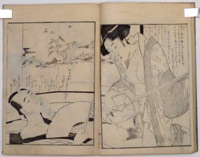
Click here to view image full size.
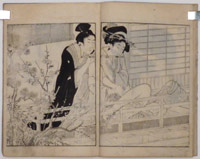
Click here to view image full size.
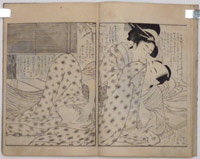
Click here to view image full size.
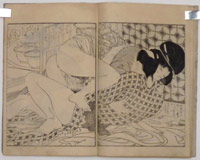
Click here to view image full size.
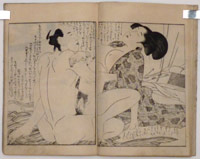
Click here to view image full size.
Kitagawa UTAMARO (1753-1806)
Click here to view image full size.
Mishima, Province of Settsu ( or Toi ) from a set of Six Crystal ( Tama ) Rivers, Furyu mu tamagawa. The streams were noted for the purity of their water and the three girls are shown fulling cloth ( hence Toi which is the alternative name of the river and the word for beating cloth ). Published by Izumiya Ichibei, c.1803-4. This appears to be from a set – like others of Utamaro’s – that could be viewed separately or as a continuous composition. See Yoshida, Utamaro zenshu, p. 173 for another design from the set. Rare.
Fine impression and colour. Full size. One minor mark, otherwise very good condition. Signed Utamaro fude.
Status: Sold
Kitagawa UTAMARO (1753-1806)
Click here to view image full size.
An aiban print: Junidan hana no nishiki, “Twelve Chapters of Floral Brocades” from Seiro Niwaka zensei asobi, “Most Splendid Entertainment of the Niwaka Festival in the Licensed Quarters.” The Festival was held in September in the Edo Yoshiwara district. Shows Minamoto no Yoshitsune visiting Princess Joruri. Not listed in Yoshida or Shibui, Ukiyoe zuten, although another version is in Yoshida, Utamaro zenshu on page 162. Published c 1802 by Yamashiroya Toemon.
Fine impression, colour and condition. Perfect colour. Signed Utamaro hitsu.
Status: Sold
Kitagawa UTAMARO (1753-1806)
Click here to view image full size.
The lovers Miuraya Agemaki and Yorozuya Sukeroku from the set: Jitsu kurabe iro no minakami, “True Feelings Compared: The Founts of Love.” A series of half-length portraits from joruri love-suicide plays with the addition of several other famous couples. This design depicts a scene from the second half of a “Sukeroku” play showing the hero Yorozuya no Sukeroku and the courtesan Agemaki from the Shimabara quarter: Sukeroku kills Ikyu, steals the heirloom sword Tomokiri-maru and the two lovers escape after Sukeroku gets soaked hiding in a water butt, and then being hidden in the voluminous surcoat of Agemaki [ as shown here ]. The set published c 1798-9 by Nishimuraya. Ex collection Adolphe Stoclet, sold Sothebys 2004, lot 239, p. 139. Bought from Murakami 17/6/1908. Other impressions: Vever, Part 1, 1974, lot 197, p. 168 ( trimmed ); Shibui, Zuten, p. 110, no. 8; Yoshida, Utamaro, 1941, no. 365; TNM, vol. 2, no. 1896. Unidentified collector’s seal bottom right.
Very good impression and colour. Slightly trimmed at top and minimally at bottom. Small edge repair. Signed Utamaro hitsu.
Status: Sold
Kitagawa UTAMARO (1753-1806)
Click here to view image full size.
No. 7 from a set of 12 prints: Joshoku kaiko tewazagusa, showing women engaged in the sericulture (silkworm) industry. This was traditionally the domain of women. The colour scheme is red-avoiding (murasaki-e) using predominantly purple. This stage of the process shows the metamorphosis – the winged moth stage – when silkworms are used to lay eggs. This set is taken verbatim from the Shunsho/Shigemasa set of chuban prints, Kaiko yashinai-gusa. (See elsewhere on this site for a Shunsho example.) Published 1798-1800 by Tsuru-ya Kiemon.
Fine impression. Fine colour, perfectly retained. Very good condition; full size. Signed Utamaro hitsu.
Status: Sold
Kitagawa UTAMARO (1753-1806)
Click here to view image full size.
Tamaya-nai Tagasode, The courtesan Tagasode of the Tamaya House. She is shown floating a model boat in a Chinese vessel. An extremely elegant composition. Published c. 1800 – 1804. Unidentified publisher’s seal. Apparently not listed in the standard Utamaro reference works.
Fine impression. Virtually unfaded with the fugitive lilac pigment on the geisha’s costume intact. Expertly repaired wormhole above signature and minor crease to the right of figure, otherwise extremely good condition. Full size. Signed Utamaro hitsu.
Status: Sold
Kitagawa UTAMARO (1753-1806)
Click here to view image full size.
The courtesan Imose of the Yoshiwara House Akatsuta-ya parading with her kamuro. Published by Yamaguchi Tobei, c early 1800’s.
Fine impression and colour. Minor edge soil, otherwise very good condition. Full size. Signed Utamaro hitsu.
Status: Sold
Kitagawa UTAMARO (1753-1806)
Click here to view image full size.
The Asahiya widow ( by reading the picture-riddle in top left box ) from Komei bijin rokkasen, “Renowned Beauties Likened to the Six Immortal Poets”. Published by Omiya Gonkuro c 1795-6. This is the first edition ( there being two later states: See The Passionate Art of Kitagawa Utamaro, Shugo Asano and Timothy Clark, no 228, p 169 ). Fine early design.
Fine impression. Some fading and trimming, otherwise very good condition. Signed Utamaro hitsu.
Status: Sold
Kitagawa UTAMARO (1753-1806)
Click here to view image full size.
A seller of fan-papers ( Jigami-uri ) and a young beauty from an untitled series of eight prints published c1797 by Tsuruya Kiemon. The idealised itinerant merchant has black fan-shaped lacquer boxes perched on his shoulder. In his hand he holds a fan with an image of Daruma eyeing the couple. The set has some excellent designs: see The Passionate Art of Kitagawa Utamaro, Shugo Asano and Timothy Clark, 1995, no. 263, p. 141, for another. Two other illustrated ( trimmed ) examples of this print are in: Ukiyo Zuten, Kiyoshi Shibui, No 13, p.77, no.2 and Utamaro Zenshu, Yoshida, p.127
Fine impression. Extremely good, unfaded colour. Full size. Extremely good condition. Au verso small Japanese collector’s seal and a dealer’s seal and description. Signed Utamaro hitsu.
Status: Sold
Artists
( A to Z )
Kyogado ASHIKUNI ( Fl. c. 1807 – 1818 )
Gigado ASHIYUKI ( Fl. c. 1814 – 1833 )
Ki BAITEI ( 1734 – 1810 )
Takizawa BAKIN ( 1767 – 1848 )
Ono BAKUFU ( 1888 – 1976 )
Georges BIGOT ( 1860 – 1927 )
Kawamura BUMPO ( 1779 – 1821 )
Ippitsusai BUNCHO ( Fl. c. 1765 – 1792 )
Toyohara CHIKANOBU ( 1838 – 1912 )
Kishi CHIKUDO ( 1826 – 1897 )
Tsubaki CHINZAN ( 1801 – 1854 )
Eishosai CHOKI ( Fl. c. 1756 – 1808 ). See also SHIKO
Rekisentei EIRI ( Fl. c. 1790 – 1800 )
Keisai EISEN ( 1790 – 1848 )
Hosoda EISHI ( 1756 – 1829 )
Hosoda EISHO ( Fl. c. 1780 – 1800 )
Ichirakutei EISUI ( Fl. c. 1790 – 1823 )
Kikugawa EIZAN ( 1787 – 1867 )
Hirano HAKUHO ( 1879 – 1957 )
Elizabeth KEITH ( 1887 – 1956 )
Imao KEINEN ( 1845 – 1924 )
Yashima GAKUTEI ( 1786 – 1868 )
Ogata GEKKO ( 1859 – 1920 )
Adachi GINKO ( Fl. c. 1847 – 1897 )
Matsumura GOSHUN ( 1752 – 1811 )
GYOSAI. See Kawanabe KYOSAI
Hirano HAKUHO ( 1879 – 1957 )
Suzuki HARUNOBU ( 1724 – 1770 )
Kawase HASUI ( 1883 – 1957 )
Kitagawa HIDEMARO ( Fl. c. early 19th century )
Kinoshita HIRONOBU ( Fl. c. 1851 – 1870 )
Gosotei HIROSADA ( Fl. c. 1847 – 1863 )
Ichiryusai HIROSHIGE ( 1797 – 1858 )
Ichiryusai HIROSHIGE II ( 1826 – 1869 )
Ando HIROSHIGE III ( 1843 – 1894 )
Nakamura HOCHU ( Fl. c. late 18th to early 19th century )
Sakai HOITSU ( 1761 – 1828 )
Totoya HOKKEI ( 1780 – 1850 )
Teisai HOKUBA ( 1771 – 1844 )
Shunkosai HOKUEI (Active 1824-1837)
Katsushika HOKUGA ( Fl. c. 1830 )
Shotei HOKUJU ( Fl. c. 1789 – 1818 )
Katsushika HOKUSAI ( 1760 – 1849 ). Also used numerous other names such as: SORI, SHUNRO, SHINSAI
Shokosai HOKUSHU ( Fl. c. 1808 – 1832 )
KEISAI. See Kitao MASAYOSHI
Suzuki KIITSU ( 1796 – 1858 )
Kitagawa KIKUMARO ( Fl. c. ? – 1830 ). See TSUKIMARO
Kobayashi KIYOCHIKA ( 1847 – 1915 )
Torii KIYOHIRO ( Fl. c. 1737 – 1771 )
Torii KIYOMASA ( Fl. c. 1700 – 1722 )
KIYOMINE. See Torii KIYOMITSU II
Torii KIYOMITSU ( 1735 – 1785 )
Torii KIYOMITSU II ( 1787 – 1868 ). See KIYOMINE
Torii KIYONAGA ( 1752 – 1815 )
Torii KIYONOBU ( 1664 – 1729 )
Torii KIYONOBU II ( 1706 – 1763 )
Torii KIYOTSUNE ( Fl. c. 1757 – 1779 )
Isoda KORYUSAI ( Fl. c. 1767 – 1788 )
Ohara KOSON ( 1877 – 1945 ). See SHOSON
Torii KOTONDO ( 1900 – 1976 )
Toyohara KUNICHIKA ( 1835 – 1900 )
Utagawa KUNIHIRO ( Fl. c. 1815 – 1843 )
Ichiunsai KUNIHISA ( 1832 – 1891 )
Utagawa KUNINAO ( 1793 – 1854 )
Utagawa KUNISADA ( 1786 – 1865 )
Utagawa KUNISADA II ( 1823 – 1880 )
Utagawa KUNISATO ( ? – 1858 )
Utagawa KUNITERU ( 1808 – 1876 )
KUNITERU. See Utagawa SADASHIGE
Utagawa KUNITERU II ( 1829 – 1874 )
Utagawa KUNIYASU ( 1794 – 1832 )
Ichiyusai KUNIYOSHI ( 1797 – 1861 )
Santo KYODEN. See Kitao MASANOBU
Kawanabe KYOSAI ( 1831 – 1889 ). See GYOSAI
Okumura MASANOBU ( 1686 – 1764 )
KitaoMASANOBU ( 1761 – 1816 ). See Santo KYODEN
Kitao MASAYOSHI ( 1764 – 1824 ). See KEISAI
Oishi MATORA ( 1794 – 1833 )
Hishikawa MORONOBU ( Fl. c. 1618 – 1694 )
Nishimura NANTEI ( 1775 – 1834 )
Utagawa NOBUKATSU ( Fl. c. 1830 – 1844 )
Watanabe NOBUKAZU ( Fl. c. late 19th century )
Hishikawa RYUKOKU ( Fl. c. 1808 – 1816 )
Jokei RYUKOSAI ( Fl. 1772 – 1816 )
Gokitei SADAFUSA ( Fl. c. 1825 – 1850 )
Hasegawa SADAHARU ( Fl. c. 1830 – 1844 )
Gokotei SADAKAGE ( Fl. c. 1818 – 1844 )
Utagawa SADAHIDE ( 1807 – 1873 )
Hasegawa SADANOBU ( 1809 – 1879 )
Utagawa SADASHIGE ( Fl. c. mid 19th century ). See KUNITERU
Gofutei SADATORA ( Fl. c. 1825 )
Yamaguchi SHIGEHARU ( 1803 – 1853 )
Kitao SHIGEMASA ( 1739 – 1820 )
Nishimura SHIGENAGA ( 1697 ? – 1756 )
Nishimura SHIGENOBU ( Fl. c. 1724 – 1735 )
SHIKO. See Eishosai CHOKI
Ryuryukyo SHINSAI ( 1764 – 1820 )
Ito SHINSUI ( 1898 – 1972 )
Kojima SHOGETSU ( Fl. c. 1880 – 1890 )
SHOSON. See Ohara KOSON
Takahashi SHOTEI ( 1871 – 1945 )
Yamamoto SHOUN ( 1870 – 1965 )
Yamakawa SHUHO ( 1898 – 1944 )
Katsukawa SHUNCHO ( Fl. c. 1780 – 1795 )
Takehara SHUNCHOSAI ( Fl. c. 1772 – 1801 )
Katsukawa SHUN’EI ( 1762 – 1819 )
Katsukawa SHUNKO ( 1743 – 1812 )
Hishikawa SHUNKYO ( Fl. c. early 19th century )
Kubo SHUNMAN ( 1757 – 1820 )
Katsukawa SHUNSEN ( Fl. c. 1762 – 1830 )
Natori SHUNSEN ( 1886 – 1960 )
Gatoken SHUNSHI ( Fl. c. 1820 – 1828 )
Katsukawa SHUNSHO ( 1726 – 1792 )
Katsukawa SHUNTEI ( 1770 – 1820 )
Katsukawa SHUNZAN ( Fl. c. 1782 – 1798 )
Yamaguchi SOKEN ( 1759 – 1834 )
Ikeno TAIGA ( 1723 – 1776 )
Katsukawa TERUSHIGE ( Fl. c. 1715 – 1725 )
Mori TETSUZAN (1775-1841)
Migita TOSHIHIDE ( 1863 – 1925 )
Mizuno TOSHIKATA ( 1866 – 1908 )
Okumura TOSHINOBU ( Fl. c. 1717 – 1750 )
Utagawa TOYOHARU ( 1735 – 1814 )
Utagawa TOYOHIRO ( 1773 – 1828 )
Utagawa TOYOKUNI ( 1769 – 1825 )
Utagawa TOYOKUNI II ( 1777 – 1835 ). See TOYOSHIGE
Yamamura TOYONARI ( 1885 – 1942 )
Ishikawa TOYONOBU ( 1711 – 1785 )
TOYOSHIGE. See Utagawa TOYOKUNI II
TSUKIMARO. See Kitagawa KIKUMARO
Kitano TSUNETOMI ( 1880 – 1947 )
Toyokawa UMEKUNI ( Fl. c. 1816 – 1826 )
Kitagawa UTAMARO ( 1753 – 1806 )
Kitagawa UTAMARO II ( ? – 1831 )
Inoue YASUJI ( 1864 – 1889 )
Hiroshi YOSHIDA ( 1876 – 1950 )
Ipposai YOSHIFUJI ( 1828 – 1887 )
Utagawa YOSHIIKU ( 1833 – 1904 )
Utagawa YOSHIKATA ( Fl. c. 1841 – 1864 )
Utagawa YOSHIKAZU ( Fl. c. 1850 – 1870 )
Toyokawa YOSHIKUNI ( Fl. c. 1803 – 1840 )
Utagawa YOSHIMUNE ( 1817 – 1880 )
Ichiyosai YOSHITAKI ( 1841 – 1899 )
Utagawa YOSHITORA ( Fl. c. 1850 – 1880 )
Taiso YOSHITOSHI ( 1839 – 1892 )
Utagawa YOSHITSURU ( Fl. c. 1840 – 1850 )
Ichieisai YOSHITSUYA ( 1822 – 1866 )
Mori YOSHIYUKI ( 1835 – 1879 )
Shibata ZESHIN ( 1807 – 1891 )
